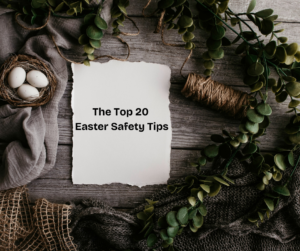The Top 20 Easter Safety Tips

Easter is fast approaching, and it’s never too late to secure your ministry and fine-tune the processes and guidelines that help safeguard children. Child safety is a major factor when visiting families consider returning, and attending families choose to continue.
Remember, “You never get a second chance to make a positive first impression.” People quickly form evaluations and judgments about safety and protection, whether negative or positive, and both create lasting images in their minds that can be difficult to change. So, it’s vital to put your best safety foot forward.
Here are twenty safety tips to help safeguard your ministry and ensure your celebration is enjoyable and incident-free.
Getting Started
1. Start by asking yourself what child safety looks like for the families I serve and the new families visiting on Easter. Understanding these perceptions will help you identify what needs improvement and where to focus your safety efforts.
2. Show new families that child safety is a top priority. Whether using an electronic solution or a manual process, you must have a well-defined check-in and check-out process. This ensures children are released only to those authorized to pick them up, allows accurate attendance records, and provides visibility to medical data (allergies) and current contact information.
Easter Goodies & Allergies
3. Implement a system to ensure staff and volunteers are aware of any allergy or medical issues with kids coming into your care.
4. Easter goodies can cause severe allergic reactions. It’s best to avoid giving children anything edible with nuts, egg products, heavy dyes, or other major allergens.
5. To prevent choking, never offer small candy or toys to children under 5 years of age. Make it a rule that small toys should never be given without supervision or consent.
Facility Safety
6. Before Easter, walk around your facility and consider ways to enhance safety in every area.
7. Invite local first responders, such as the fire and police departments, to tour the children’s area and recommend ways to increase safety.
8. If your egg hunt occurs indoors, designate specific areas to ensure eggs are not hidden in low-visibility areas, near electrical outlets, or other dangerous spots with minimal supervision. This will prevent children from running all over the facility unsupervised.
9. Stock first aid kits, hand sanitizer, extra wipes for spills, and check defibrillators to ensure they work correctly. Click here if you need to design and build a first aid kit.
10. Keep first aid kits in a closed container in a marked and easily accessible location.
Training and Safety Protocols
11. Make sure all staff and volunteers in the children’s area have updated or recently passed background checks.
12. Identify staff and volunteers with badges, colored shirts, or different colored lanyards. This ensures children only approach approved adults.
13. When preparing volunteers for Easter services, ramp up training. This ensures you cover logistical details, roles and responsibilities, child safety protocols, and facility layout.
14. Implement the Two-Adult Rule safety guideline, which states that at all times, at least two fully screened adults and two children must be present. Establishing that one adult should never be alone with a child.
15. Have parents or guardians take their children to the restroom before checking them in.
16. Establish bathroom procedures. While young children use the bathroom, do not allow adults or teenagers to enter.
17. Determine appropriate classroom ratios and divide children into age-appropriate groups to prevent bumps, bruises, and trampling.
Emergency Information
18. Have emergency information available in each classroom and main gathering areas, such as laminated lists of important contact information, evacuation routes, and what to do in case of a weather disturbance, violence, or threats. Click here to download an Emergency Instructions Flip Book.
Security Team
19. Reach out and familiarize yourself with the security team. They are an excellent resource for incident management and are trained to deal with conflict.
20. Request safety resources, including dedicated security personnel, communication devices, or access to messaging apps for the children’s area.
Click here to learn more about the benefits of using secure mobile Express Check-In, children’s and youth check-in, and volunteer scheduling to help manage your Easter event.
For more safety information, subscribe to the KidCheck blog or connect with us on X, Facebook, Pinterest, Instagram, and YouTube.
Photo by Anna Helsinki on Unsplash


